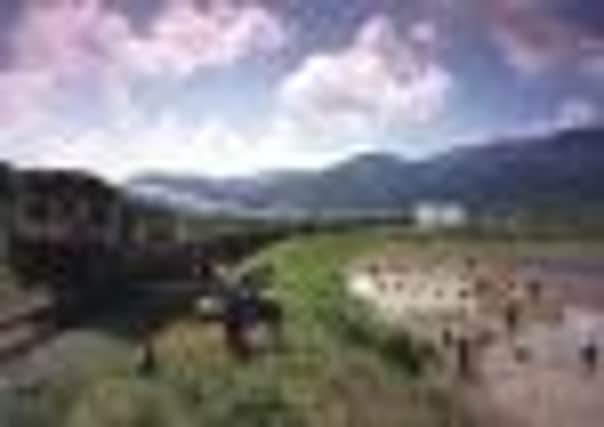Travel: The iconic railway between Bangkok and Singapore


I am starting an epic three-day journey, travelling in style aboard the Eastern & Oriental Express along one of the world’s most iconic rail routes, a 2,030km ride from Bangkok to Singapore, through regions of incredible natural beauty and important historical significance.
As we pick up speed, I stand in the open-air observation car, the carriages rocking and rivets squeaking over old steel tracks. Onlookers waiting on rundown platforms wave enthusiastically, genuinely pleased to see the train. Children run as fast as their little legs will carry them to try to catch up.
Advertisement
Hide AdThe route winds its way from Bangkok to Singapore, passing through Wang Po and over the famous wooden trestle viaduct at Tham Kasae. The train also traverses the River Kwai bridge, Kanchanaburi, then crosses the border into Malaysia, taking in the towns of Padang Besar, Butterworth, Georgetown and, after an excursion to Penang Island and across the Bukit Merah Lake in northern Malaysia, on to Kuala Lumpur, the Johur Causeway and journey’s end in Singapore. Launched in 1993, the Eastern and Oriental Express – E&O – is the sister train of the Venice Simplon-Orient-Express and has 20 carriages in total, 12 sleepers furnished with day couches that transform into beds and small bathrooms with walk-in showers, two bars and two restaurant cars where the food produced is exquisite.
The train attracts a variety of travellers of all ages, although the average is between 50 and 60; there are the hardcore returnee passengers, novice first-timers, honeymooners and couples celebrating various anniversaries. Famous passengers include Bryan Adams, Lord Andrew Lloyd Webber, Dame Shirley Bassey, members of the Thai royal family and, most recently, the Japanese fashion designer Kenzo Takada.
After dinner, a smart affair with men in jackets and ties and women in summer eveningwear, I return to my compartment, where my personal cabin steward, Weenus Chomloy, has transformed the space into a cosy bedroom. My seat is now a freshly made bed with crisp white linens and plump pillows.
Overnight, we chug along, the train rocking from side to side and soothing me into a deep sleep as we travel slowly for 255km towards Wang Po and Kanchanaburi town. I wake early to my first sighting of the River Kwai.
At Kanchanaburi, we trade the comfort of the train for a raft that carries us along the Kwai, stopping off to visit the Thai-Burma Railway Centre and Museum and the Don-Rak War Cemetery, which contains hundreds of graves of allied prisoners-of-war.
At the museum, Australian founder Rod Beattie explains the history of the railway and bridge. During the Second World War, when the Japanese invaded Thailand and Burma, they decided a rail link between the two was essential and forced some 61,000 British, Dutch, Australian and American prisoners, as well as 250,000 men from Burma, Malaya, China, India and Indonesia (then the Dutch East Indies), to build it. Tens of thousands had died by the time the rail link was completed and it became know as the Death Railway.
Advertisement
Hide AdBack on the train, we head south through semi-tropical jungle and agricultural areas with small farms, peaked-roof houses, green paddy fields, duck farms, prawn farms and small herds of skinny Brahmin cattle.
Large posters of the much-loved King of Thailand feature enormously throughout the Thai section of this rail journey. Gradually the landscape becomes more rural, and green velvet paddy fields appear, dotted with white egrets searching for food. And then we stop. The train’s locomotive, provided by the Thai railway, has overheated and we are forced to sit on the track until a replacement is found.
Advertisement
Hide AdNow behind schedule, we don’t have time to visit Penang Island (once the capital of British Malaya) or George-town, and so instead spend time in the piano bar car sipping cocktails and listening to jazz and blues classics performed by the resident pianist.
The following morning, a lush and more tropical environment greets me through the window; a green corridor of paddy fields, jungle, small farms, palm and vast rubber tree plantations, and we cross over the border into Malaysia. Here the train runs more smoothly, as we pass down the Malay peninsula, where a massive development of the railway will see new tracks and bridges laid from the border to Singapore.
Efficiency is good but it sometimes lacks the beauty of history, and when we enter Singapore over the Straits of Johor it is into the ugly concrete woodlands Train Checkpoint building, 12 miles from the centre, rather than the beautiful Tanjong Pagar art deco station on Keppel Road. The old station closed in June 2011 as part of a political agreement between Singapore and Malaysia, but there are talks of turning it into a museum.
Still swaying from side to side, we leave the train and take a taxi to Singapore’s buzzing Marina Bay development, where we check in at the Mandarin Oriental hotel for an overnight stay. Next day, we continue to travel in style, only this time aloft, on board an Emirates flight home.
• A seven-night package to Bangkok and Singapore, including three nights on the Eastern & Oriental Express, costs from £3,395 per person through Emirates Tours (020 7590 1485, www.emiratestours.co.uk). The price is based on two people sharing and includes return economy-class flights from Glasgow and private car transfers (valid for travel from 11 August to 9 December 2013).
The Thai-Burma Railway Centre museum (www.tbrconline.com) holds a database of soldiers killed during construction of the railway. For a small fee, help is available to tracked down lost relatives.